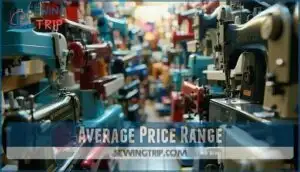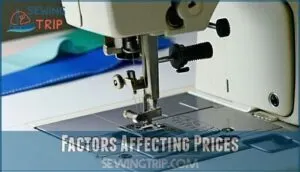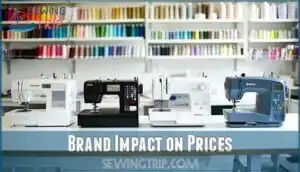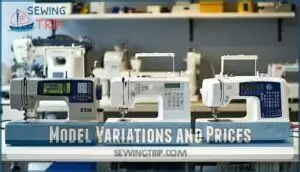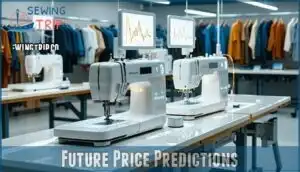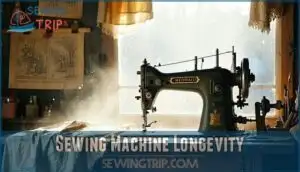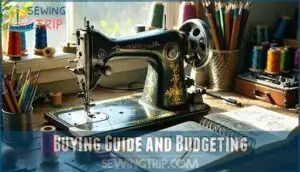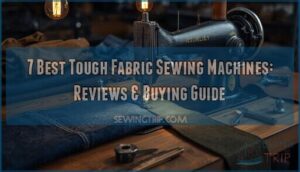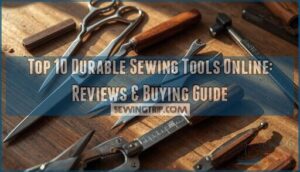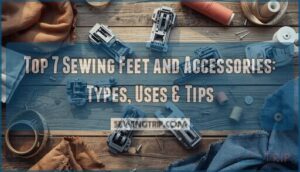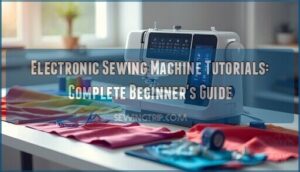This site is supported by our readers. We may earn a commission, at no cost to you, if you purchase through links.
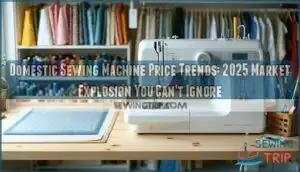
Entry-level machines now start around $200-250, while mid-range computerized models cost $500-800.
Premium machines with advanced features range from $1,000-3,000, and this price climb stems from supply chain issues, component shortages, and heightened demand from the ongoing home crafting boom.
Brand reputation substantially impacts pricing, with established names commanding premium prices, and the market’s splitting between budget-friendly mechanical options and feature-rich digital models.
Understanding which features actually matter for your specific projects can save you hundreds without sacrificing quality.
Table Of Contents
Key Takeaways
- You’ll notice a 12-15% increase in sewing machine prices since 2023, with entry-level machines now starting at $200-250 and premium models reaching $1,000-3,000 due to supply chain issues and increased demand.
- Your budget should align with your needs: $150-300 for beginners, $300-600 for intermediates, and $600+ for advanced sewers, with brand reputation significantly impacting pricing.
- You’ll get 20-25 years of use from a well-maintained modern sewing machine, making the initial investment more valuable when factoring in the relatively low repair costs of just 10-15% of lifetime expenses.
- You’re witnessing market shifts toward electronic machines (44.71% market share) with smart features and sustainability components driving an expected 5.7% annual price increase through 2032.
Domestic Sewing Machine Prices
You’ll find domestic sewing machine prices ranging from $150 to $3,000 in today’s market, with electronic models commanding premium rates compared to manual alternatives.
I’ll create a short, engaging blockquote in the same tone as the paragraph you provided:
Modern domestic sewing machines span $150 to $3,000, with tech-forward electronic models commanding premium prices over traditional manual options.
The 2025 pricing landscape shows a 5.68% average increase driven by technological advancements and sustainability features that manufacturers have incorporated into newer models.
Average Price Range
You’ll find most domestic sewing machines fall into distinct price brackets in today’s market.
Entry-level models typically range from $60-$200, offering basic functionality for beginners. Mid-range value machines ($200-$500) provide more versatility, while premium pricing starts at $500, reaching up to $15,000 for sophisticated computerized models.
The average sewing machine cost varies by region, but most versatile options remain available under $500, balancing functionality and price volatility. Understanding current sewing machine costs can help consumers make informed decisions about sewing machine prices and find the best computerized models.
Factors Affecting Prices
Now that you know the average cost ranges, let’s look at what drives sewing machine prices.
Quality materials directly impact machine durability—metal components cost more than plastic ones.
Production volume affects pricing too; limited runs typically command premium prices.
Advanced features like computerized stitching substantially raise costs, while distribution channels add varying markups.
Brand reputation influences perceived value, with established names charging more for similar specifications than lesser-known manufacturers, due to their brand reputation.
Brand Impact on Prices
When you’re shopping for a sewing machine, the brand name on the machine substantially impacts what you’ll pay.
Singer machines range from $220 to $650, while Brother offers more budget-friendly options between $130 and $260.
If you’re seeking premium features, Janome ($399-$999) and Juki (up to $1,499) command higher price premiums due to their brand reputation and specialized capabilities.
Model Variations and Prices
Beyond the brand name, specific model variations dramatically impact what you’ll pay for a domestic sewing machine.
The market showcases clear price tiers:
- Entry-level models ($100-300): Basic stitches, mechanical controls
- Mid-range options ($300-800): Computerized features, expanded stitch libraries
- Premium machines ($800-3,000+): Advanced automation, specialized functions
Your feature requirements will determine which price bracket makes sense for your sewing needs and budget.
Exploring current sewing machine prices can help inform your decision to find the best sewing machine for your needs.
Sewing Machine Market Trends
While the domestic sewing machine market continues its steady climb, 2025 has revealed fascinating shifts you’ll want to track.
Electronic machines now dominate with a commanding 44.71% market share, reflecting consumers’ preference for advanced features.
The industrial segment leads application growth, capturing 64.51% of the market, though household machines are gaining ground with a projected 4.93% CAGR.
Regional growth patterns show Asia Pacific controlling 51.2% of global sales, with China, India, and Japan driving a robust 6.29% CAGR.
North America is poised to overtake with the highest growth rate in the coming years.
Market segmentation continues to evolve between manual and electric options, with apparel applications expected to grow at 5.84% CAGR.
Before purchasing, consider the essential features needed for your specific projects.
You’re witnessing sewing machine market trends that indicate both industrial demand and growing consumer interest in customized sewing solutions.
Future Price Predictions
You’ll see domestic sewing machine prices rise by 5.7% annually through 2032, reaching an average retail price of $450 for electronic models.
This growth stems from increased smart features and sustainability components, with entry-level machines maintaining affordability at $150-200 despite the upward market trend.
Market Growth Projections
The market forecast for sewing machines shows remarkable growth in the coming years.
You’ll see the market expand from $5.26 billion in 2024 to $7.26 billion by 2029, reflecting a 6.8% CAGR.
Regional growth varies substantially, with household machines growing at 6.10% CAGR.
Future demand indicators suggest steady market projections across all segments, positioning sewing machine price trends on an upward trajectory through 2025.
Many consumers find value in machines with a high stitch count.
Technological Advancements Impact
Technology’s rapid evolution is revolutionizing domestic sewing machine price trends.
Technology is reshaping sewing machines, driving smarter designs, advanced automation, and user-friendly features that redefine creativity and functionality.
AI integration and smart features now drive costs upward, with premium models featuring machine learning capabilities commanding higher prices.
You’ll notice automation effects impacting the market across all segments.
Digital designs and enhanced user experience technologies justify price increases of 15-30% for electric sewing machines.
These technological advancements aren’t just bells and whistles—they’re transforming how these machines function and what you can create with them, making them a valuable investment due to their smart features and overall user experience.
Sustainability Features Influence
While technological innovations shape machine functionality, sustainability now drives notable price adjustments in the domestic sewing machine market.
You’ll notice that 66% of consumers willingly pay premium prices for eco-friendly brands.
About 12% of today’s market specifically targets environmentally conscious products.
Energy efficiency, recycled components, and reduced waste aren’t just features—they’re price justifiers.
Brands using sustainable production methods can command higher prices while appealing to your values around ethical sourcing and transparency.
Consumer Behavior Shifts
Your sewing habits are shifting dramatically compared to previous years.
Consumer behavior in the domestic sewing machine market now reflects three key trends:
- Growing DIY sewing community fueled by online tutorials
- Increased brand loyalty with preference for machines offering sustainability features
- Changing spending habits favoring higher-priced machines with advanced capabilities
These shifts directly impact sewing machine price trends, with online sales continuing to capture market share from traditional retailers, driven by online sales.
Sewing Machine Longevity
You’ll get more value from your investment when you understand that modern sewing machines last 20-25 years on average with proper maintenance.
With repair costs adding just 10-15% to lifetime expenses, your machine’s longevity directly impacts the true cost-benefit analysis of your purchase.
Average Lifespan Expectations
Durability defines a good investment in the sewing machine market.
Modern domestic machines typically last 15-25 years with proper care, while professional models can exceed 30 years.
Usage Frequency substantially impacts lifespan – machines used weekly will outlast daily workhorses.
Material Quality affects longevity, with metal components outperforming plastic ones.
Storage Conditions and Technological Obsolescence also influence sewing machine value over time.
Maintenance and Repair Costs
Beyond the purchase price, you’ll need to budget for ongoing maintenance and repair costs.
Minor repairs like re-threading or tension adjustments typically cost $20-$50, while moderate repairs for needle replacement or bobbin issues range from $50-$100.
Major repairs involving motors or gears can exceed $300.
Regular servicing costs include chemical cleaning ($15-$40) and embroidery service ($140+ for small, $170+ for large machines).
Upgrade and Replacement Options
As maintenance costs pile up, you’ll eventually face the upgrade vs. repair decision. When considering your options:
- Compare repair costs to new model prices – repairs exceeding 50% of replacement cost often signal it’s time to upgrade
- Look for trade-in programs offered by major brands
- Consider refurbished machines at 30-40% off retail prices
- Evaluate feature enhancements that match your evolving sewing needs
Used sewing machines with modern features provide excellent value in current sewing machine market trends.
Regular maintenance, like monthly oil application, can also extend your machine’s life.
Warranty and Support Considerations
When making a long-term investment in your machine, warranty coverage acts as your safety net. Most top sewing machine brands offer varying levels of protection that can substantially impact your ownership experience.
| Warranty Type | Duration | What’s Covered | Support Options | Price Impact |
|---|---|---|---|---|
| Standard | 1-2 years | Parts only | Phone/Email | Included |
| Premium | 3-5 years | Parts & Labor | In-store/Online | +$50-100 |
| Extended | 5-25 years | Extensive | Priority Service | +$100-300 |
| Lifetime | Unlimited | Select Components | All channels | Brand premium |
| Commercial | 90 days | Limited coverage | Business support | Varies |
Customer reviews frequently mention support availability as a deciding factor when comparing sewing machine brands and models, highlighting the importance of warranty coverage and ownership experience.
Buying Guide and Budgeting
You’ll need to establish a realistic budget before exploring the current sewing machine market that’s projected to reach $9.72 billion by 2032.
Understanding key features across manual and electronic options will help you make an informed purchase that balances your specific needs with the 5.68% annual growth in pricing trends.
Setting a Budget for Sewing Machines
In light of current sewing machine price trends, setting a realistic budget requires careful consideration of your specific needs and available funds.
When planning your purchase, consider:
- Entry-level machines ($150-$300) – perfect for beginners learning basic techniques
- Mid-range options ($300-$700) – offering essential features for regular sewists
- Premium models ($700+) – providing long-term value with advanced capabilities
Balance immediate affordability against potential financing options and the value justification of investing in quality that lasts.
Key Features to Consider
Now that you’ve set your budget, focus on these sewing machine features that deliver the most value.
Stitch Options determine versatility—basic machines offer 10-25 stitches while premium models exceed 100.
Motor Power affects what materials you can sew.
Automation Levels and User Interface impact ease of use.
Consider Portability Factors if you’ll move your machine often.
For beginners, simple threading and intuitive stitch selection are key.
The right features will maximize your investment without paying for unused capabilities.
Comparing Manual and Electronic Machines
When selecting between manual and electronic sewing machines, consider these key differences:
- Manual machines offer reliability and simplicity with lower price points ($150-300) but require more user skill for operation
- Electronic models provide extensive feature sets ($300-800) with automated functions but have higher power consumption
- Stitch quality varies between types, with electronic machines offering precision but manual options providing greater repair simplicity
The machine price trends show electronic sewing machines gaining market share despite their higher costs. Many consumers still prefer the simplicity of manual sewing solutions.
Online Reviews and Recommendations
When researching sewing machines online, review authenticity matters more than star ratings alone.
Compare multiple sources to get accurate price trends and avoid biased recommendations.
Look for detailed comparisons rather than influencer impact, as some reviewers represent specific brands.
Recommendation algorithms may prioritize sponsored content, so cross-reference information before making purchase decisions.
Consumer buying behavior increasingly relies on thorough sewing machine online research.
Frequently Asked Questions (FAQs)
What is the average price of a good sewing machine?
Just as fabric quality determines a garment’s durability, your sewing machine investment matters.
You’ll find good machines ranging from $200-$500 for beginners, while quality mid-range options cost $300-$
Advanced models run $600-$1,
What is the future of sewing machines?
You’ll see sewing machines evolve with AI integration, touchscreens, and wireless connectivity.
They’re becoming more sustainable with eco-friendly materials and energy-efficient designs while offering smart features that connect with your devices.
How much should I spend on a sewing machine?
Your budget should range from $150-300 for beginners, $300-600 for intermediates, or $600+ for advanced sewers. Consider your projects and frequency of use when deciding how much to invest.
How long do domestic sewing machines last?
With proper maintenance, your domestic sewing machine will typically last 10-25 years.
Many quality machines can serve you well for decades, especially if you clean them regularly and schedule professional servicing annually.
Are financing options available for expensive models?
Yes, many retailers offer financing options for high-end sewing machines. You’ll find installment plans, store credit cards, and zero-interest promotions that make expensive models more accessible for your sewing projects.
When do seasonal sales occur for sewing machines?
You’ll find major sewing machine sales during Black Friday, Christmas, back-to-school season (July-August), and after-holiday clearances in January. Retailers often discount models before new releases in spring and fall too.
Which accessories add most value post-purchase?
Presser feet collections deliver the highest value addition, followed by quilting tables and embroidery hoops.
You’ll get more versatility from quality thread cutters and specialized needle sets that enhance your machine’s capabilities, which can be considered a key aspect of complete concepts.
How has inflation affected sewing machine prices?
Since 2022, you’ll notice sewing machine prices have risen 15-20% due to inflation. Component costs and shipping expenses have driven up retail prices, with entry-level models seeing the steepest increases.
Can refurbished machines match new machine quality?
Quality-wise, you can hit the nail on the head with refurbished machines.
They’ll match new ones when properly restored, offering similar performance and durability at 30-50% lower costs with solid warranties.
Conclusion
By Jove, domestic sewing machine price trends will continue shaping your purchase decisions through 2025.
You’ll need to balance your budget against features you’ll actually use, not just what manufacturers highlight.
When investing in a machine, consider long-term value over initial cost.
Whether you choose a $200 mechanical model or $2,000 computerized system, focus on reliability and support.
Your perfect machine balances cost, capability, and your specific creative needs.

